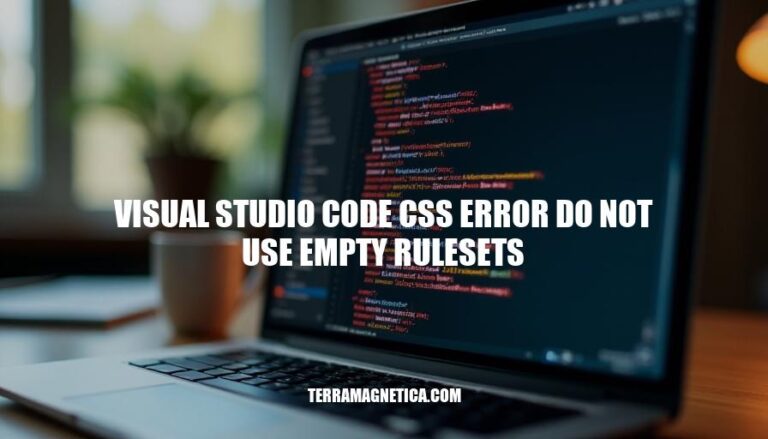


In Visual Studio Code, the CSS error “Do not use empty rulesets” occurs when a CSS block is defined without any properties. This warning is significant because empty rulesets can lead to unnecessary code clutter and potential performance issues, as some browsers may still process these empty blocks. Addressing this error helps maintain clean, efficient, and optimized CSS code.
The “Do not use empty rulesets” error in Visual Studio Code occurs when a CSS ruleset is defined without any properties or values inside it. This error is triggered when the linter detects a CSS block that looks like this:
#example {
/* No properties here */
}
Empty rulesets are flagged because they don’t serve any purpose and might indicate a mistake or incomplete code. To resolve this, you can either add properties to the ruleset or remove it entirely if it’s not needed.
The “Do not use empty rulesets” error in Visual Studio Code typically occurs when you have CSS rulesets that don’t contain any properties. Here are some common scenarios that lead to this error:
Forgotten or Incomplete Code:
/* Example of an empty ruleset */
.container {
}
Temporarily Commented Out Properties:
.header {
/* background-color: blue; */
}
Placeholders for Future Styles:
.footer {
/* Styles will be added later */
}
Conditional Styles with No Default:
.sidebar {
/* Styles applied conditionally via JavaScript */
}
These empty rulesets can be resolved by either adding the necessary properties or removing the empty rulesets altogether.
The “Do not use empty rulesets” error in Visual Studio Code flags CSS rulesets that don’t contain any properties. Ignoring this error can lead to several issues:
Addressing this error ensures cleaner, more efficient, and maintainable CSS code.
/* Example of an empty ruleset */
#box { }
#box {
background-color: lime;
padding: 10px 20px;
}
Ctrl + Shift + P (or Cmd + Shift + P on macOS).Preferences: Open User Settings and select it.css.lint.empty.CSS Lint: Empty Rules to ignore.Ctrl + Shift + P (or Cmd + Shift + P on macOS).Preferences: Open User Settings (JSON) and select it.{
"css.lint.emptyRules": "ignore",
"scss.lint.emptyRules": "ignore"
}
.vscode folder..vscode folder, create a settings.json file.settings.json file.{
"css.lint.emptyRules": "ignore",
"scss.lint.emptyRules": "ignore"
}
These steps should help you resolve the ‘Do Not Use Empty Rulesets’ error in Visual Studio Code.
Remove Empty Rulesets: Always ensure your CSS rulesets contain at least one property. If a ruleset is empty, delete it.
Use CSS Preprocessors: Tools like Sass or Less can help manage your CSS more efficiently, reducing the likelihood of empty rulesets.
Linting Tools: Use CSS linting tools like Stylelint to automatically detect and warn you about empty rulesets.
VS Code Settings: Adjust your VS Code settings to ignore empty ruleset warnings if they are not critical for your project. Add the following to your settings.json:
"css.lint.emptyRules": "ignore",
"scss.lint.emptyRules": "ignore"
Code Reviews: Regularly review your code or use peer reviews to catch and remove any empty rulesets.
Automated Testing: Implement automated tests that check for empty rulesets as part of your CI/CD pipeline.
These practices will help maintain clean and efficient CSS, reducing the chances of encountering this error.
You can follow these steps:
Preferences: Open User Settings‘, search for css.lint.empty, and change the setting to ignore.settings.json or create a .vscode folder with a settings.json file containing the configuration.It’s essential to address this error as empty rulesets can lead to inefficient CSS development. To maintain clean code, remove empty rulesets, use CSS preprocessors like Sass or Less, and utilize CSS linting tools like Stylelint.
Adjust your VS Code settings to ignore empty ruleset warnings if necessary, conduct regular code reviews, and implement automated testing to catch and remove any empty rulesets as part of your CI/CD pipeline. By following these practices, you can maintain efficient and clean CSS development.